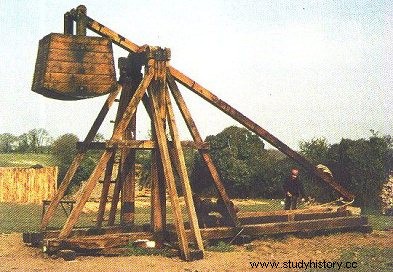
Type Siege engine
Time 12th century - 16th century
Number of servants 60
Weights and dimensions
Mass counterweight from 10 to 18 tons
Total length yard from 8 to 12 meters
Mass of the projectile 80 to 100 kg
Range 200 m
Rate of fire 1 to 2 shots per hour
The trebuchet is part of the medieval artillery pieces known as counterweight. It is a siege engine that was used in the Middle Ages, either to destroy the masonry of the walls, or to launch projectiles over the fortifications. It is sometimes called a "counterweight trebuchet" to differentiate it from an older weapon called a "traction trebuchet", an early version of the device where the propelling force was provided by men and not by a counterweight.
The counterweight trebuchet appeared in the first part of the 12th century in the countries around the Mediterranean both in Christian lands and in regions controlled by Muslims1.
It could launch projectiles from three hundred pounds (140 kg) and hurl them at high speed against enemy fortifications.
Under certain circumstances, corpses infected with different diseases were catapulted into towns with the aim of spreading epidemics among the besieged, it is a medieval variant of biological warfare.
The counterweight trebuchet appeared in China around the 4th century BC. in Europe in the 6th century AD and it would not become obsolete until the 16th century, well after the introduction of gunpowder.
The trebuchet is much more accurate than other medieval catapults. During the Crusades, Richard Coeur de Lion gave evocative and picturesque names to the two trebuchets used during the siege of Saint-Jean-d'Acre in 1191 "the catapult of God" and "bad neighbour". Trebuchet construction techniques were lost in the early 16th century.
